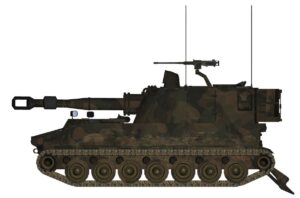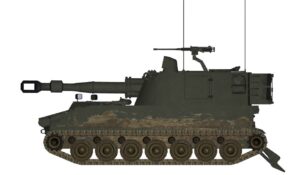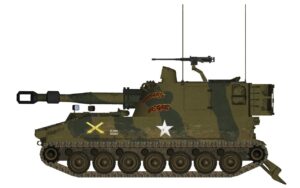Introduction
The M109A1 is a late Cold War era self-propelled howitzer of US origin. The M109A1 is the iconic Cold War era self-propelled howitzer used by NATO forces. The M109A1 is the intermediate model of the M109 family. It is a successor to the short barrel Vietnam era M109 and predecessor to the more capable A5 and Paladin models.
Design
The M109A1 is a modernized Vietnam era M109. The main improvement being the much longer 39-caliber 155mm howitzer. This has a longer effective range than the older 23-caliber howitzer, and can fire an expanded family of shells. The chassis and turret remain mostly similar. A range of incremental upgrades was applied through various improvement programs, finally resulting in the A4 model.
Firepower
The 155mm M185 howitzer set the new NATO standard, with foreign designs adopting the 39-caliber barrel length. The World War 2 era M107 shell can be fired out to 18.1 km. This is a 3.5 km range increase compared to the older M109. The M549A1 rocket assisted shell has a range of 23.5 km. Maximum rate of fire is 4 rpm. Normal rate of fire is 2 rpm and 1 rpm for sustained fire. For self-defense a 12.7mm M2HB heavy machine gun is fitted at the commander’s cupola.
Mobility
The tracked chassis provides the M109A1 with a decent road speed and good mobility in the field. A 405 hp diesel engine in the hull front provides propulsion. With preparation the M109A1 is amphibious. Some foreign models lack the amphibious capability.
Protection
The hull and turret are made of welded aluminum, with a thickness of 32 mm. This provides protection against small arms fire and shell splinters. The M109A1 if often operated under full armor protection. During sustained fire some of the crew members work behind the vehicle, feeding shells and charges through the rear hatches.
Users
The M109A1 and related models were acquired in significant numbers by the US military. Over 4.000 were produced, including many conversions from the Vietnam era M109. Many US allies adopted the M109A1. Often these vehicles feature some local modifications. In US service the much improved M109A6 Paladin replaced the M109A1. Several European nations acquired the PzH 2000, while South Korea acquired the K9 Thunder. Nonetheless, many nations still use M109A1 today.





